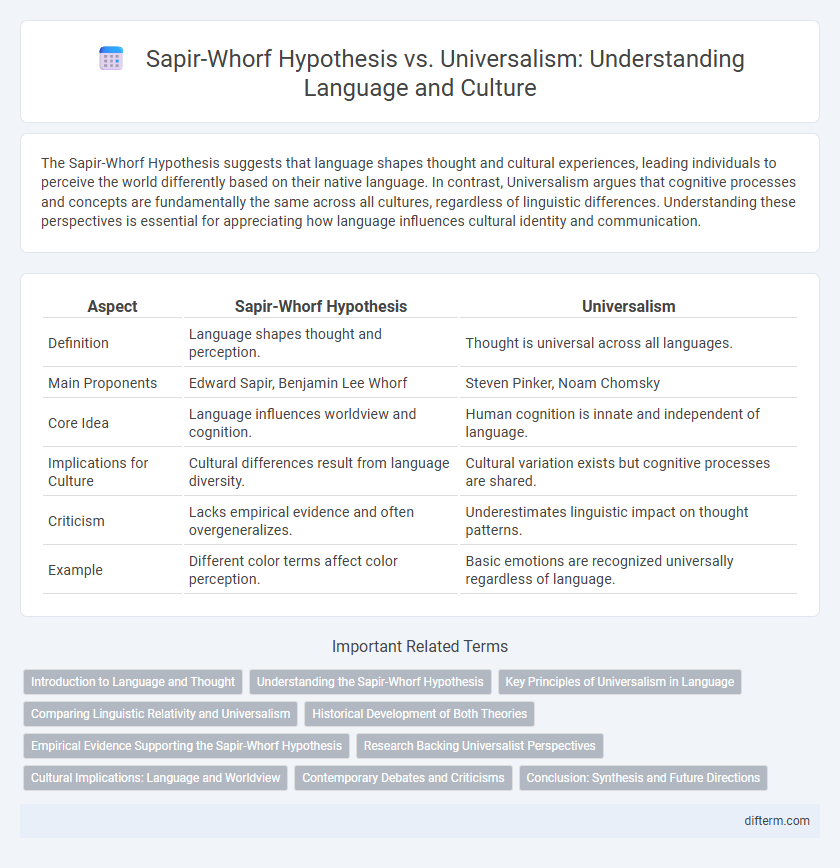The Sapir-Whorf Hypothesis suggests that language shapes thought and cultural experiences, leading individuals to perceive the world differently based on their native language. In contrast, Universalism argues that cognitive processes and concepts are fundamentally the same across all cultures, regardless of linguistic differences. Understanding these perspectives is essential for appreciating how language influences cultural identity and communication.
Table of Comparison
| Aspect | Sapir-Whorf Hypothesis | Universalism |
|---|---|---|
| Definition | Language shapes thought and perception. | Thought is universal across all languages. |
| Main Proponents | Edward Sapir, Benjamin Lee Whorf | Steven Pinker, Noam Chomsky |
| Core Idea | Language influences worldview and cognition. | Human cognition is innate and independent of language. |
| Implications for Culture | Cultural differences result from language diversity. | Cultural variation exists but cognitive processes are shared. |
| Criticism | Lacks empirical evidence and often overgeneralizes. | Underestimates linguistic impact on thought patterns. |
| Example | Different color terms affect color perception. | Basic emotions are recognized universally regardless of language. |
Introduction to Language and Thought
The Sapir-Whorf Hypothesis posits that language shapes thought, suggesting that speakers of different languages perceive reality in distinct ways due to linguistic differences. In contrast, Universalism argues that cognitive processes are largely innate and human thought shares a common structure regardless of language. Studying these perspectives in linguistic anthropology reveals crucial insights into how culture influences both language development and cognitive patterns.
Understanding the Sapir-Whorf Hypothesis
The Sapir-Whorf Hypothesis posits that language shapes thought and perception, implying that speakers of different languages experience reality in distinct ways. This linguistic relativity challenges Universalism, which argues that cognitive processes and concepts are fundamentally the same across cultures regardless of language. Understanding the Sapir-Whorf Hypothesis highlights how cultural differences in language influence worldview, cognition, and communication patterns.
Key Principles of Universalism in Language
Universalism in language asserts that all human languages share an underlying structure and cognitive framework based on universal principles of human thought. Key principles include the innate capacity for language acquisition, the existence of common grammatical categories across languages, and the idea that linguistic diversity arises from variations on shared cognitive concepts. Universalism contrasts with the Sapir-Whorf hypothesis by emphasizing biological and cognitive universals rather than culture-specific linguistic relativity.
Comparing Linguistic Relativity and Universalism
Linguistic Relativity, as proposed by the Sapir-Whorf Hypothesis, emphasizes that language shapes thought and cultural perception, suggesting cognition varies across linguistic groups. Universalism argues that cognitive processes and cultural concepts are fundamentally the same worldwide, independent of language differences. This contrast highlights how linguistic structures either influence or reflect universal human cognition and cultural understanding.
Historical Development of Both Theories
The Sapir-Whorf Hypothesis, developed in the early 20th century by linguists Edward Sapir and Benjamin Lee Whorf, argues that language shapes thought and cultural perception. In contrast, Universalism, rooted in Enlightenment philosophy and later cognitive science, contends that certain cognitive structures and concepts are innate and shared across all human cultures. The historical development of these theories reflects an ongoing debate between linguistic relativity and inherent cognitive universals in anthropology and linguistics.
Empirical Evidence Supporting the Sapir-Whorf Hypothesis
Empirical evidence supporting the Sapir-Whorf Hypothesis includes studies on color perception, where speakers of languages with distinct color terms demonstrate different color discrimination abilities, indicating language shapes cognitive processes. Research on spatial orientation in Aboriginal Australian languages reveals unique linguistic structures influencing spatial memory and navigation, contrasting with Universalist views that cognitive categories are innate and uniform across cultures. These findings suggest that language profoundly influences thought patterns, challenging universalist assumptions about the independence of cognition from linguistic variation.
Research Backing Universalist Perspectives
Research backing universalist perspectives highlights cognitive and neurological studies showing common patterns of thought and perception across cultures. Experiments on color recognition and basic emotions demonstrate shared human experiences regardless of linguistic differences. These findings challenge the Sapir-Whorf Hypothesis by supporting the idea that language reflects rather than determines thought.
Cultural Implications: Language and Worldview
The Sapir-Whorf Hypothesis asserts that language shapes an individual's worldview, emphasizing the cultural implications of linguistic relativity in cognitive processes and perception. Universalism argues that despite linguistic differences, there are underlying cognitive structures shared across cultures that influence human understanding uniformly. This debate highlights the interplay between language diversity and shared human experience in shaping cultural identity and communication.
Contemporary Debates and Criticisms
Contemporary debates on the Sapir-Whorf Hypothesis center around its assertion that language shapes thought, contrasting sharply with Universalism's claim of innate cognitive structures independent of linguistic variation. Critics argue that strong linguistic determinism overstates language's influence, citing cross-cultural studies and cognitive science evidence that support universal cognitive patterns. Recent research employs neuroimaging and psycholinguistics to explore how linguistic relativity manifests variably across cultures, challenging both extremes and promoting a nuanced understanding of language-cognition interplay.
Conclusion: Synthesis and Future Directions
The Sapir-Whorf Hypothesis emphasizes linguistic relativity, suggesting language shapes thought and culture, while Universalism argues for innate cognitive patterns shared across humanity regardless of language. Synthesizing these perspectives highlights that cultural cognition results from both language influence and universal mental frameworks, demanding interdisciplinary research integrating linguistics, psychology, and anthropology. Future directions involve advanced neurocognitive studies and cross-cultural experiments to unravel how language and universal cognitive architectures jointly shape cultural understanding and social behavior.
Sapir-Whorf Hypothesis vs Universalism Infographic

 difterm.com
difterm.com